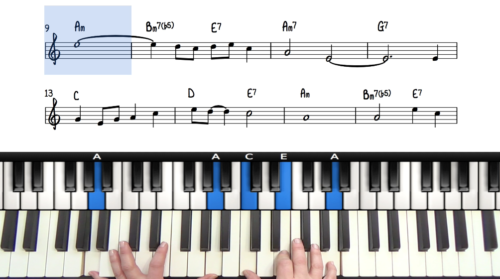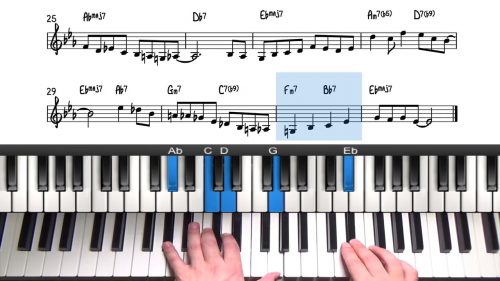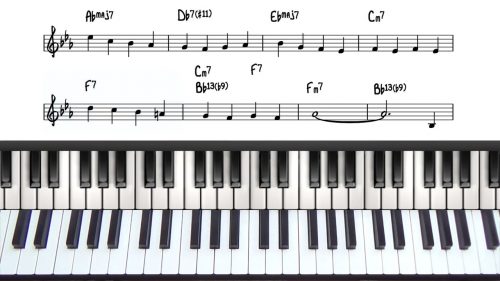There Will Never Be Another You – Harmonic Analysis
In the last lesson we explored the most common forms that you will come across. We’re now going to pick 1 tune “There Will Never Be Another You” and we’ll analyse the harmony to help memorise & internalise the changes
There are 3 good reasons why you should memorise jazz standards:
Firstly, if you are reading a lead sheet, or looking at a chart, then you will be losing focus and energy that should be directed at your playing.
Next, when playing in a band, you should be communicating and interacting with the other musicians. If you are concentrating on a score, then you may be missing out on much of what is going on in the band.
Finally, internalising the chord changes will help you get the most out of your transcribed lines and solos.
Assess The Form
Looking at iRealPro chart for "There Will Never Be Another You", we can see that it follows an A-B-A-C form. That means that the A Section is repeated twice, and those 8 bars make up 50% of the tune. The first 3 bars of the C Section are identical to the B Section, and then we have an alternate ending to finish the tune.
After analysing the form, we now know which sections are repeated. The next step is to group chords together to shorten the amount of information you need to remember.
Simplifying The Information
By grouping related chords together, we can simplify the 8 bar A section down to 4 pieces of information. Remember that the A Section appears twice in the form that’s half the tune. The numeric labels such as “25 of 6” and “25 of 4” will give you a deeper understanding of the harmony and help you transpose the tune.
Let’s repeat this for the rest of the form.
Practice Tips
-
Always relate the harmonic movement back to the key of the tune.
-
You will then have the 'blueprint' to transpose the tune into any key.
-
If you are working with a vocalist, it’s highly likely that you will be required to change the key, and so this numeric formula or ‘blueprint’ is invaluable to work out the new chords.
- Check out Lyndol's course on "How To Accompanying singers" for more information on transposing tunes for vocalists.





Hi Heyden!
Just curious about how best to conceptualise shifting tonal centres. It seems that when we have these secondary relationships, we can still think of the melody in terms of the overall key if we want to. So the “V of V” for example, is “within” the overall key, forming a hierarchical structure – we can either hear the V as an inner tonal centre, or hear the tonal centre of the overall piece etc.
But then we look at a piece such as Tune Up, which feels like it is actually shifting key centre with each ii-V-I, as opposed to being the ii-V-I of something else. Can Tune Up really be analysed with respect to an overall key centre, or is this a different structure at play? The B section of Autumn of New York is another one that is confusing.
I am not sure if I have articulated the question well enough, but in essence it is: When does a piece actually modulate to a different tonal centre, and when do we hear shifting key centres as an inner level “within” the overall key centre?
Thanks again,
Jamie
Hi Jamie, it’s Tuomo from PG!
Thanks for writing! Here some ideas.
Important thing first, when you go through and analyze thoroughly more, let’s say about 10-15 songs, you will start to find your own personal way of understanding and analyzing harmony. The main goal is to have a good overview of the song, doesn’t matter how you get there as long as you understand what’s going on.
Now to your question.
First ‘There Will Never Be Another You’. You are right, there is no reason to overthink this song, as every movement is clearly within the key (moving to relative minor, to the IVth, back door cadence etc.) Even in the 5th last bar, as Hayden explained on the video, Aø7 D7 (II V to IIIrd degree) is very common in tonal music.
In general, if the song moves to any of the basic scale degrees, there is no need to think of a modulation. With this I mean scale degrees that are ‘natural’, and derived from the notes of the core scale (see attachment). For example, in the key of Ebmaj, if the song goes to C-7, it is clearly within the key, but if it goes to Cmaj, then I would definitely think of a modulation. Or whenever you see Bb7 in a song in the key of Eb, of course we think of a V, but if we see Bbmaj, that would be a modulation.
When it comes to songs you mentioned, or any other song that moves somewhere that is not part of the core scale degrees, I would consider it a modulation, and start thinking in the new key instead of relating to the original.
Remember what are our main goals we want to achieve with analyzing: detect harmonic movements (II V Is etc.)AND help us be faster with transposing.
Let’s take ‘Tune Up’. Starts in Dmaj, moves to Cmaj and Bbmaj. As the key centers are clearly outside of the Dmaj scale degrees, they are modulations. Now, most important thing we need to understand is where does the song modulate in RELATION to the starting key of the song.
Cmaj is b7th in the key of Dmaj, and Bbmaj is b6th. This information makes it very easy to transpose ‘Tune Up’ to any key.
I guess the main point I’m trying to make is that it’s good to stay within the original key as much as possible, and even when you think of modulation, relate it to the original key. When you do this long enough, you’re not anymore thinking in any specific key, instead you see the bigger picture, where it doesn’t really matter what key you are in, you just see the relation between the harmonic movements.
To summarize:
I hope this helped, let me know if you have any further questions,
-Tuomo
Thank you very much Tuomo for writing such a thorough and helpful reply! It has helped clear up a big area of confusion with respect to tonicisation vs modulation, as well as reinforced the point that our analysis is to some extent personal, and all about what is most cognitively efficient.
Hi Jamie,
I’m glad to help, let me know if you have any further questions,
-Tuomo
Good day, I have to say this is one of the best lessons I have found one the site or anywhere concerning “analyzing the changes”. I’ve learned a lot from this and will try to do more of it
Thanks